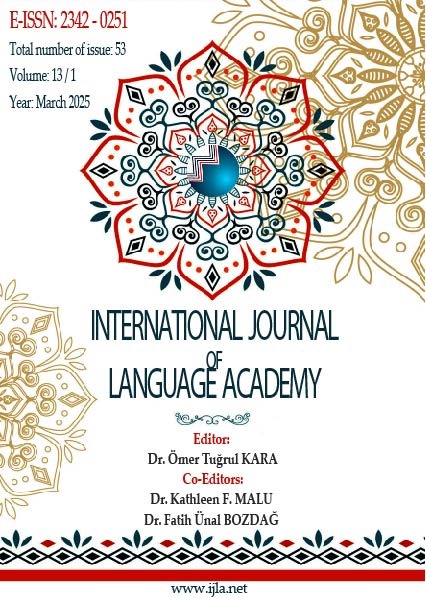Author :
Abstract
Bu araştırmada, ortaokul öğrencilerinin eleştirel okuma öz yeterlikleri ve okuma motivasyonları arasındaki ilişkinin belirlenmesi amaçlanmıştır. Ayrıca öğrencilerin eleştirel okuma öz yeterlikleri ile okuma motivasyonlarının okulun sosyoekonomik düzeyi ile bu becerilerin öğrencilerin sınıf düzeyi ve cinsiyetleri açısından farklılık gösterip göstermediği de incelenmiştir. Araştırmada nicel araştırma yöntemlerinden ilişkisel tarama modeli kullanılmıştır. Araştırma örneklemini İstanbul ili Sancaktepe ilçesinde bulunan ve farklı sosyoekonomik düzeylerde olan üç ortaokulda öğrenim gören 632 öğrenci oluşturmaktadır. Araştırma örneklemi oluşturulurken okulların belirlenmesinde seçkisiz örnekleme yöntemlerinden amaçlı, belirlenen okullardan öğrenci seçilirken ise basit olasılıklı örnekleme yöntemi kullanılmıştır. Araştırmada veriler; “Kişisel Bilgi Formu”, “Eleştirel Okuma Öz Yeterlik Ölçeği” ve “Okuma Motivasyonu Ölçeği” kullanılarak elde edilmiştir. Araştırma verileri, SPSS 26 paketi ile analiz edilmiş; analizde betimsel istatistiki analizler ile parametrik testler olan Bağımsız Örneklemler T Testi, ANOVA ve Pearson Çarpım Moment Korelasyon kullanılmıştır. Araştırma bulgularına göre eleştirel okuma öz yeterliği ve okuma motivasyonu arasında orta düzeyde, pozitif ve anlamlı bir ilişki vardır. Öğrencilerin eleştirel okuma öz yeterlikleri ve okuma motivasyonları “orta” düzeydedir. Öğrencilerin eleştirel okuma öz yeterlikleri ile okuma motivasyonları; okulun sosyoekonomik düzeyi ile öğrencilerin sınıf düzeyi ve cinsiyetine göre anlamlı olarak farklılaşmaktadır. Bu farklılaşma; okulun sosyoekonomik düzeyine göre orta düzeydeki okullar, cinsiyete göre ise kız öğrenciler lehinedir. Bununla birlikte öğrencilerin sınıf düzeylerinin yükselmesiyle eleştirel okuma öz yeterlikleri ile okumaya yönelik motivasyonlarının düştüğü görülmektedir.
Keywords
Abstract
This study aimed to determine the relationship between middle school students' critical reading self-efficacy and reading motivation. In addition, it was also examined whether students' critical reading self-efficacy and reading motivation differ in terms of the socioeconomic level of the school and whether these skills differ in terms of student's grade level and gender. The relational survey model, one of the quantitative research methods, was used in the study. The research sample consists of 632 students studying in three middle schools in the Sancaktepe district of Istanbul province at different socioeconomic levels. While forming the research sample, the purposive sampling method, one of the random sampling methods, was used to determine the schools, and the simple probability sampling method was used to select students from the determined schools. Data were obtained by using the “Personal Information Form,” “Critical Reading Self-Efficacy Scale,” and “Reading Motivation Scale.” The research data were analyzed with the SPSS 26 package; descriptive statistical analysis and parametric tests such as Independent Samples T Test, ANOVA, and Pearson Product Moment Correlation were used. The research findings show a moderate, positive, and significant relationship between critical reading self-efficacy and reading motivation. Students' critical reading self-efficacy and reading motivation are at a “moderate” level. Students' critical reading self-efficacy and reading motivation differ significantly according to the socioeconomic level of the school, the grade level, and the students' gender. This differentiation is in favor of middle-level schools according to the socioeconomic level of the school and in favor of female students according to gender. However, it is seen that students' critical reading self-efficacy and motivation for reading decrease with the increase in grade level.





